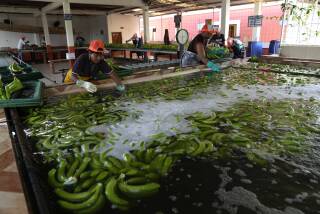Jamaica’s Police Get More ‘Mules’ to Cough Up Drugs
- Share via
KINGSTON, Jamaica — Little more than a year ago, so many poor Jamaicans were swallowing sealed drug packets before boarding planes to Britain that at least 60 a week were being arrested at Heathrow Airport and a London tabloid branded Jamaica’s national airline “Cocaine Air.”
But since June 2002, high-tech screening equipment at Jamaica’s two international airports has so vastly improved detection of people who swallow or stash drugs elsewhere in their bodies that this country’s notorious “drug mules” are becoming an endangered species.
Authorities caught six times more mules last year than in 2001, and most were intercepted within two months of the IonScan equipment’s installation, said Gilbert Scott, deputy chief of the Ministry for National Security.
The machines can detect even tiny amounts of narcotics on a smuggler’s body or belongings. Passengers identified as having been in contact with narcotics may then be subjected to an ultrasound scan to look inside their body.
That success came at a price, though, as hospital emergency rooms in Kingston and Montego Bay at first were flooded with detained suspects from departing flights.
Though airport screeners could immediately pinpoint suspected smugglers with 95% accuracy, authorities had to wait to file formal charges until the swallowers -- who account for the vast majority of mules -- passed the evidence through their systems in the presence of hospital staff.
A defense lawyer here said an average of 10 to 12 passengers from each of Air Jamaica’s 11 weekly flights to Britain were arrested here last summer and fall.
“It did put a strain on our medical services, but it was not insurmountable,” Scott said. “And it has tapered off, along with the arrests, as word has spread that if you try it you are going to be caught.”
Still, the fight against transshipment of drugs through this Caribbean nation from Colombia to North American and European markets is far from won, as dealers in the lucrative trade are probably finding other means of delivery, Scott acknowledged.
“Between 100 and 120 metric tons of stuff flows through on an annual basis. We have no reason to believe that this has changed,” he said, but thanks to the scanning machines, less of it appears to be leaving the island by mule these days.
Assistance from the main destination countries has also helped. Britain paid for the IonScan equipment, and the United States recently donated three fast boats to give the Jamaican Coast Guard a fighting chance against the high-powered crafts of the drug lords.
The U.S. Drug Enforcement Administration has been training the Jamaican Coast Guard, and it is paying off in “significantly increased interdiction,” said Orna Blum, spokeswoman for the U.S. Embassy here.
With the technological advances and training has come a change in some countries’ tactics, requiring Jamaicans to obtain visas before travel to allow at least cursory checks of their means and motives.
Britain and Bermuda instituted visa requirements for Jamaicans this year, joining the U.S. and Canada, to protect themselves from drugs as well as illegal immigration.
Since the policy took effect Jan. 9, the British High Commission had issued more than 10,000 visas to Jamaicans after rejecting 39% of applicants, said commission spokesman Mark Waller.
In recent years, British-bound flights have been beset by drug “muling” -- the term for transporting narcotics by ingesting them or packing them into body cavities or baggage -- as traffickers seek ways to overcome a logistical challenge. Drugs can be delivered more reliably to the larger North American market by sea due to its proximity to South America.
And strategically located Jamaica has become the first stop for Colombian drugs, according to Jamaica’s senior superintendent of police, Carl Williams, with as much as 10% of the world’s cocaine supply passing through the island.
Little of the contraband stays in Jamaica, because few here can afford it. But the island has long been a reliable source of mules, predominantly poor women, who can earn upward of $2,000 for delivering drug balloons.
The trade has enriched the gangs in Jamaican cities who help move it on and off the island by boat. It has also set off a violent crime wave that is chasing away the country’s most important source of legal income: tourists.
Authorities hope that the threat of steadily improving interception will dissuade traffickers from trying to move drugs through Jamaica, which would undermine the power and wealth of local organized-crime leaders.
But police acknowledge that they are able to catch only a fraction of the drugs coming through.
“It’s long been our analysis that the drug trade is the primary source of criminal activity,” Scott said. “So if we can continue to improve interdiction, we should be able to reduce overall crime.”
More to Read
Sign up for Essential California
The most important California stories and recommendations in your inbox every morning.
You may occasionally receive promotional content from the Los Angeles Times.











